Scottish maternal and infant nutrition survey 2017
Results from the 2017 Scottish Maternal and Infant Nutrition Survey. This first Scotland-only survey gathered data on maternal nutrition and infant feeding.
4. Infant Nutrition: Feeding Choices
One of the aims of the Maternal and Infant Nutrition Framework for Action is that all parents should receive information they can understand to help them to make an informed choice about how to feed their infants.
To help achieve this aim, The Scottish Government has created the Feedgood.scot website. ( R22) This online resource, launched in July 2016, provides families with information and advice about feeding choices, "how to guides" relating to various aspects of feeding, and advice about where to find further support.
NHS Health Scotland has also produced a number of publications to help support families including:
- Ready Steady Baby: Your complete guide to pregnancy, birth and parenthood. ( R11)
- Off to a good start: all you need to know about breastfeeding. ( R20)
- Formula feeding: How to feed your baby safely. ( R23)
- Fun first foods: An easy guide to introducing solid foods. ( R24)
Families are also offered information about feeding choices when they attend antenatal appointments / classes during pregnancy.
This section of the report presents information on respondents' feeding intentions prior to giving birth and the sources of information they used. All results are based on responses received from the mothers who completed the 8-12 week survey.
4.1 Feeding intention
Prior to giving birth, 74% of respondents to the 8-12 week survey reported that they had intended to give breast milk to their new baby. Forty-two percent (42%) had planned to breastfeed only, 18% planned to combine breastfeeding with expressing breast milk, and 14% said that they planned to mix feed (combine giving breast milk with formula feeding). Less than 0.5% of respondents had intended to express milk only.
One in five respondents (20%) had planned to formula feed only. A small proportion of respondents (6%) had been undecided about their feeding intentions prior to giving birth.
[Figure 4.1; Table 4.1a]
Before the birth, nearly three-quarters of respondents had intended to give breast milk to their new baby.
Figure 4.1: Before your new baby was born, how would you describe your intentions for feeding your baby? (Percentage of respondents who stated each intention).
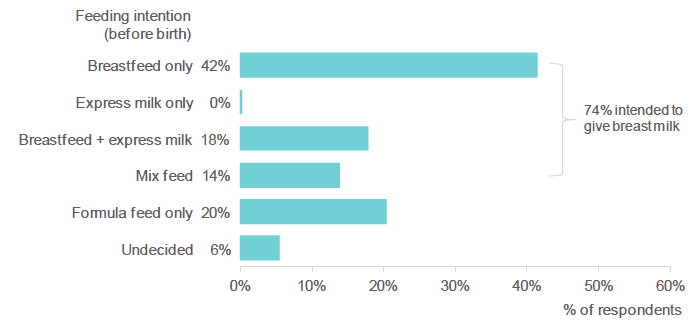
Source: Q21, 8-12 Week Survey
In the 2010 UK-wide Infant Feeding Survey, 70% of Scottish mothers reported that they had intended to give breast milk; 59% breastfeed only, and 11% mix feed. In the earlier survey, 21% of respondents had intended to formula feed only, and 8% had not decided how they were going to feed their baby. ( R7)
There was no option in the 2010 survey for a respondent to indicate that she intended to express milk only or to combine breastfeeding and expressing; it is assumed that these respondents would have reported that they intended to breastfeed.
Previous feeding experience
Overall, first time mothers were more likely to report that they intended to give breast milk (76%) than respondents who already had children (71%). First time mothers were also more likely to report that they intended to breastfeed / express milk only (64%) than respondents who already had children (55%). However, feeding intention varied markedly amongst respondents who already had children and intentions largely reflected previous infant feeding experience.
[Figure 4.2; Table 4.1a & 4.1b]
Feeding intention varied widely depending on previous infant feeding experience.
Figure 4.2: Before your new baby was born, how would you describe your intentions for feeding your baby? (Percentage of respondents who stated each intention, by whether this was respondent's first baby and by previous feeding experience).
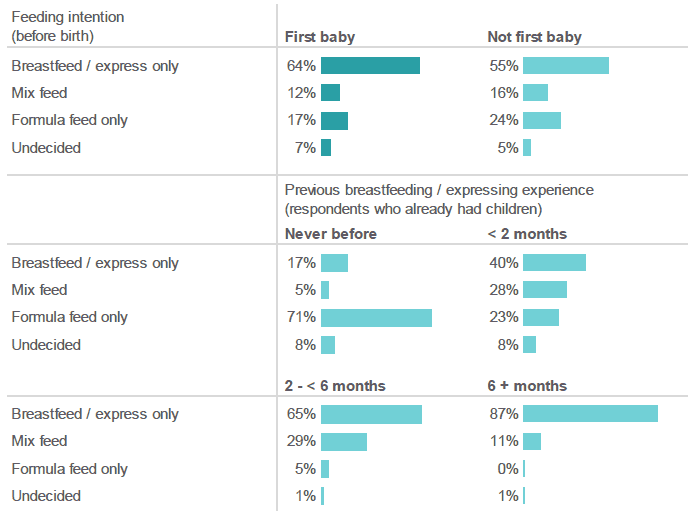
Source: Q21, Q18, Q19, 8-12 Week Survey
- Only 21% of respondents who already had children, but who had never breastfed / expressed milk before, intended to give breast milk to their new baby (17% breastfeed / express only; 5% mix feed). The majority of these mothers intended to formula feed (71%).
- The intention to give breast milk became progressively stronger depending on the length of time that a mother had previously breastfed / expressed.
- 68% of mothers who had previously breastfed / expressed milk for less than two months intended to do so again (40% breastfeed / express only; 28% mix feed).
- This increased to 93% amongst mothers who had previously breastfed / expressed for more than two but less than six months (65% breastfeed / express only; 29% mix feed).
- 98% of respondents who had previously breastfed / expressed milk for six months or more intended to do so again for their new baby (87% breastfeed / express only; 11% mix feed).
[ Figure 4.2; Table 4.1a & 4.1b]
Age of respondent
Older respondents were more likely to have stated an intention to breastfeed / express milk for their new baby than younger respondents:
- 80% of those aged 35 or over, stated that they had intended to give breast milk (65% breastfeed / express only; 15% mix feed).
- In contrast, only 57% of 20-24 years stated an intention to give breast milk (48% breastfeed / express only; 10% mix feed).
- Younger respondents were more likely to have expressed an intention to formula feed only. Thirty-five percent (35%) of respondents aged 20-24 stated this intention; this decreased to 15% for those aged 35 or over.
- No results are presented for mothers aged 19 or under; there were too few respondents in this age group to produce meaningful results.
[Table B1: 8-12 Week – Results by Age of Respondent]
Deprivation
Feeding intention also varied depending on whether respondents lived in the most / least deprived areas:
- Nearly two-thirds of respondents (65%) who lived in the most deprived areas had intended to give breast milk to their new baby ( SIMD 1: 52% breastfeed / express only; 13% mix feed). This compared to nearly 82% of those living in the least deprived areas ( SIMD 5: 65% breastfeed / express only; 17% mix feed).
- More than a quarter of respondents who lived in the most deprived areas had intended to formula feed only ( SIMD 1: 28%). This intention was reported less frequently amongst respondents who lived in the least deprived areas ( SIMD 5: 12%).
[Table B2: 8-12 Week – Results by SIMD]
Medical reasons preventing ability to breastfeed / express milk.
Three percent (3%) of respondents reported that they had a medical reason that prevented them from breastfeeding / expressing milk (for example breast surgery or medication).
[Table 4.2]
Strength of intention to breastfeed
Amongst respondents who had intended to breastfeed at all (exclusively or in combination with expressing breast milk or formula feeding), the majority (68%) agreed that they were keen to continue breastfeeding even if they experienced problems (42% strongly agree; 26% agree).
However, respondents were more likely to agree that they would not continue to breastfeed if there were problems that made it harder for their baby (such as not settling or gaining weight), than if they encountered problems that made it harder for themselves (such as sore nipples).
Sixty-three percent (63%) of respondents agreed that if they encountered problems making it harder for their baby they would not continue to breastfeed. This compared to 20% who agreed that they would not continue if there were problems affecting themselves.
[Figure 4.3; Table 4.3]
Most respondents who had intended to breastfeed were keen to continue breastfeeding even if they experienced problems.
Figure 4.3: Response to statements about pre-birth intention to breastfeed. (Percentage of respondents who selected each response in relation to each statement. Respondents who intended to breastfeed, breastfeed and express milk, or mix feed).

Source: Q22, 8-12 Week Survey
Intention to formula feed only
Half of respondents (51%), who had intended only to give formula milk, agreed that they would breastfeed or express milk if their baby was born premature or unwell; nearly a third (31%) of these respondents agreed with this strongly.
Twelve percent (12%) of respondents who had intended only to give formula milk agreed that they "felt under pressure to breastfeed". However, two-thirds (66%) of these respondents disagreed with this statement.
Less than 1% of respondents who intended to formula feed only reported feeling "under pressure to formula feed".
[Figure 4.4; Table 4.4]
Half of respondents who intended to formula feed only said that they would breastfeed and/or express milk if their baby was born premature or unwell.
Figure 4.4: Response to statements about pre-birth intention to formula feed only. (Percentage of respondents who selected each response in relation to each statement. Respondents who intended to formula feed only).
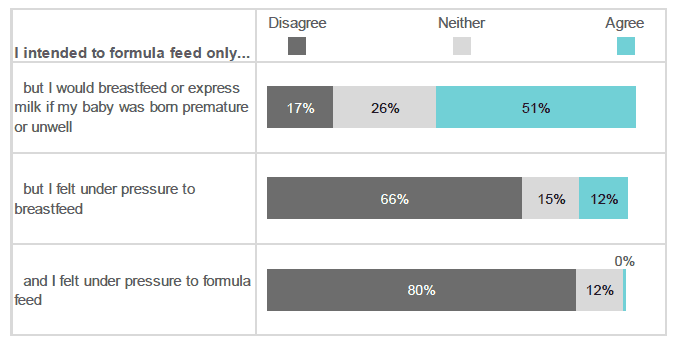
Source: Q23, 8-12 Week Survey
4.2 Sources of information
Discussion with a health professional
The majority of respondents (80%) had discussed their thoughts about feeding their baby with a health professional when they were pregnant. Most respondents (71%) indicated that this discussion had been helpful and, overall, 17% indicated that it had influenced their choice.
However, 15% of respondents reported that they had not had a discussion about feeding their baby with a health professional when they were pregnant.
[Figure 4.5; Table 4.5]
Eighty percent of respondents discussed their thoughts about feeding their baby with a health professional during pregnancy.
Figure 4.5: Did a health professional discuss your experiences and thoughts about feeding your new baby with you during your pregnancy? (Percentage of respondents who selected each response). [15]
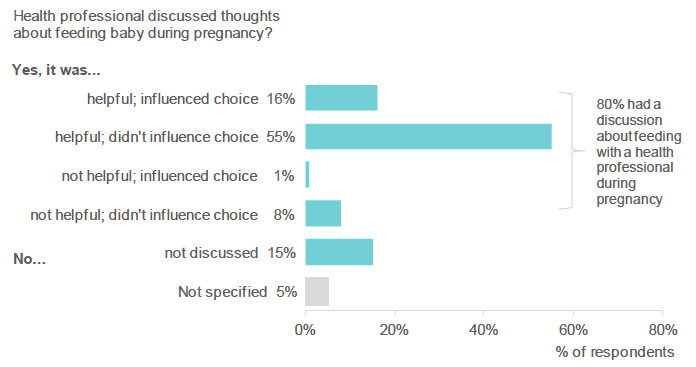
Source: Q24, 8-12 Week Survey
Five percent (5%) of respondents did not indicate whether or not they had discussed feeding with a health professional during pregnancy ("Not specified"). [15] Amongst respondents who did answer this question, 84% reported that a discussion had taken place, while 16% reported that it had not. This result is very similar to comparable results from the 2010 UK-wide Infant Feeding Survey, where 84% of Scottish respondents said that feeding had been discussed at an antenatal check-up. ( R7)
[Table 4.6]
Feeding intention [16]
Amongst respondents who indicated whether or not a discussion had taken place, those who had intended to breastfeed / express milk only were more likely to report having had a helpful discussion (76%) than respondents who had intended to formula feed only (69%).
Respondents who had intended to give formula milk only were much less likely to report having had a discussion that had influenced their feeding choice (5%) than mothers who had intended to breastfeed / express only (21%), mothers who had intended to mix feed (23%), and mothers who had been undecided about how to feed their baby (19%).
[Figure 4.6; Table 4.6]
Most respondents who intended to give formula milk exclusively found the discussion with a health professional about feeding helpful, but it rarely influenced their choice.
Figure 4.6: Did a health professional discuss your experiences and thoughts about feeding your new baby with you during your pregnancy? (Percentage of respondents who selected each response, by feeding intention prior to birth).
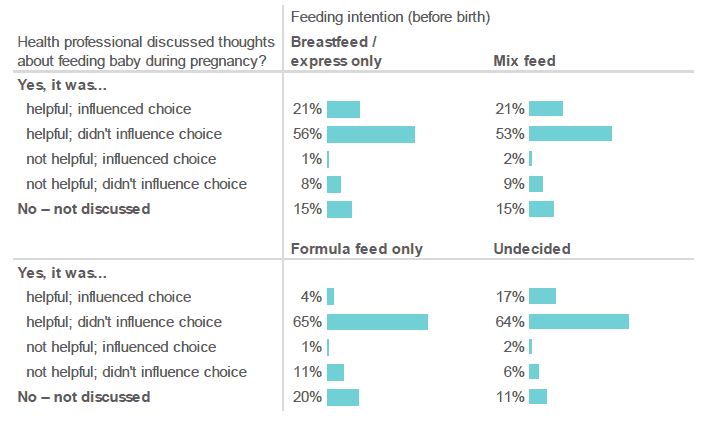
Source: Q24, Q21, 8-12 Week Survey
NHS board of residence [17]
Amongst respondents who indicated whether or not a discussion had taken place, there was some regional variation in the proportion of mothers who reported having a discussion about feeding with a health professional when they were pregnant.
In NHS Forth Valley, only 74% of respondents reported having a discussion, whereas 92% of respondents living NHS Grampian and 91% of respondents in NHS Highland reported having this discussion.
A high proportion of respondents who lived in NHS Dumfries & Galloway and the island boards ( NHS Western Isles, NHS Orkney and NHS Shetland) had a discussion with a health professional; however only a small number of respondents (<= 50) lived within these areas and results should be treated with caution.
[Figure 4.7; Table B3: 8-12 Week – Results by Board]
Respondents who lived in some NHS board areas were more likely to report having a discussion with a health professional about feeding their baby.
Figure 4.7: Did a health professional discuss your experiences and thoughts about feeding your new baby with you during your pregnancy? (Percentage of respondents, by NHS board of residence).

Source: Q24, 8-12 Week Survey
Other sources of information
The majority of respondents (82%) reported that they had received a copy of the NHS Health Scotland booklet entitled "Off to a good start: all you need to know about breastfeeding". ( R20) This booklet aims to help pregnant women and new mothers make decisions about how to feed their baby. Nearly half of respondents (47%) indicated that they had read the booklet, and a further quarter (25%) had "looked at it a bit".
In contrast, less than a quarter of respondents (23%) were aware of the "feedgood.scot" website, ( R22) an online NHSScotland resource providing advice and information about feeding choices. Only 8% of mothers reported that they had looked at this website.
[Figure 4.8; Table 4.7a & 4.7b]
The majority of respondents received a copy of "Off to a good start", but most were not aware of the "feedgood.scot" website.
Figure 4.8: While you were pregnant, did you receive a copy of the booklet "Off to a good start: all you need to know about breastfeeding"? / Are you aware of the feedgood.scot website? (Percentage of respondents who selected each response).
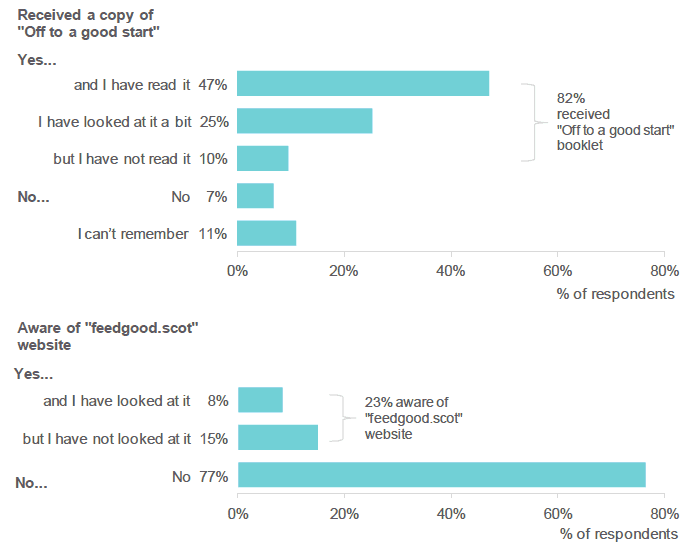
Source: Q25 , Q27, 8-12 Week Survey
Respondents who had looked at the "Off to a good start" booklet and the "feedgood.scot" website generally found theses resources to be useful:
- 81% of respondents who had read / looked at the "Off to a good start" booklet indicated that they had found it useful (28% very useful, 53% quite useful).
- 90% of respondents who had looked at the "feedgood.scot" website indicated that they had found it useful (43% very useful, 47% quite useful).
[Figure 4.9; Table 4.8a & 4.8b]
Most respondents who had looked at "Off to a good start" or the "feedgood.scot" website found these resources useful.
Figure 4.9: How useful was the "Off to a good start" booklet? / How useful was the "feedgood.scot" website? (Percentage of respondents who selected each response. Respondents who had looked at the booklet / website).
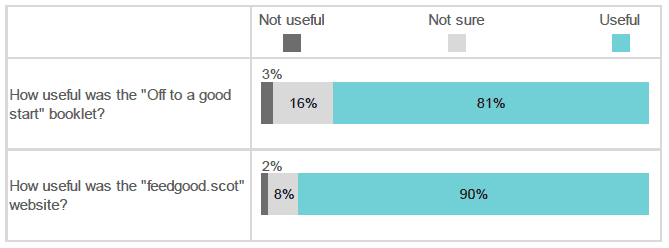
Source: Q26, Q28, 8-12 Week Survey
Contact
There is a problem
Thanks for your feedback